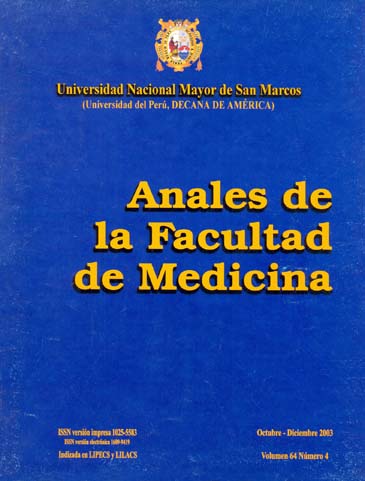Cutaneous Leishmaniasis vectors study at Rimac Valley
DOI:
https://doi.org/10.15381/anales.v64i4.1416Keywords:
Leishmaniasis, psychodidae, phlebotomusAbstract
Objectives: To determine the composition of Lutzomyia species at the Rimac valley. Material and methods: The area studied was the Ullupampa annex (2000 msnm), San Jeronimo de Surco district, Huarochiri province, Lima. The sandflies were captured using Shannon traps, CDC light traps and direct capture, in intra and peridomiciliary ambient and natural refuges. Results: We identified 1742 phlebotomine sandflies of the Lutzomyia genus, 52,6% corresponded to Lutzomyia verrucarum, 28,2% to Lutzomyia peruensis, and 19,2% to Lutzomyia noguchi; the first two were more abundant in intra and peridomiciliary ambients, and the latest in natural refuges. Lutzomyia density presents seasonal variations, mostly found between March and May. Night activity peak is between 20 and 21 hours. Conclusions: Fruit cultivations surrounded housings separated by “pircas” and domestic animals within the house favor L. peruensis and L. verrucarum hematophagous activity in the domiciliary ambient; they represent the main leishmaniasis vectors at Rimac valley.Downloads
Published
2003-12-31
Issue
Section
Trabajos originales
License
Copyright (c) 2003 ABELARDO TEJADA, ABRAHAM CÁCERES, JUAN MIRANDA, OLGA PALACIOS, VÍCTOR ZORRILLA

This work is licensed under a Creative Commons Attribution-NonCommercial-ShareAlike 4.0 International License.
Those authors who have publications with this magazine accept the following terms:
- Authors will retain their copyrights and guarantee the journal the right of first publication of their work, which will be simultaneously subject to Creative Commons Attribution License that allows third parties to share the work as long as its author and its first publication this magazine are indicated.
- Authors may adopt other non-exclusive licensing agreements for the distribution of the version of the published work (eg, deposit it in an institutional electronic file or publish it in a monographic volume) provided that the initial publication in this magazine is indicated.
- Authors are allowed and recommended to disseminate their work over the Internet (eg: in institutional telematic archives or on their website) before and during the submission process, which It can produce interesting exchanges and increase quotes from the published work. (See El efecto del acceso abierto ).
How to Cite
1.
Tejada A, Cáceres A, Miranda J, Palacios O, Zorrilla V. Cutaneous Leishmaniasis vectors study at Rimac Valley. An Fac med [Internet]. 2003 Dec. 31 [cited 2024 Jul. 17];64(4):218-22. Available from: https://revistasinvestigacion.unmsm.edu.pe/index.php/anales/article/view/1416















